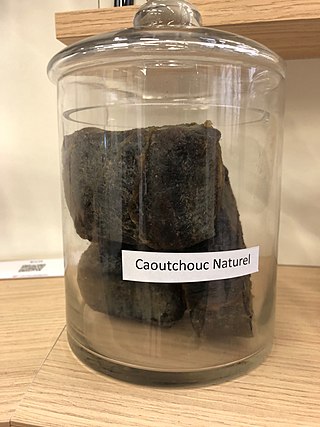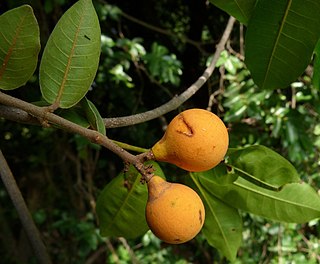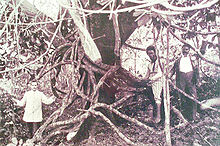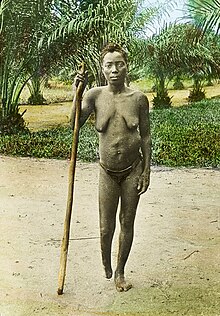
Rubber, also called India rubber, latex, Amazonian rubber, caucho, or caoutchouc, as initially produced, consists of polymers of the organic compound isoprene, with minor impurities of other organic compounds. Thailand, Malaysia, Indonesia, and Cambodia are four of the leading rubber producers.

The Congo Free State, also known as the Independent State of the Congo, was a large state and absolute monarchy in Central Africa from 1885 to 1908. It was privately owned by King Leopold II, the constitutional monarch of the Kingdom of Belgium. In legal terms, the two separate countries were in a personal union. The Congo Free State was not a part of, nor did it belong to Belgium. Leopold was able to seize the region by convincing other European states at the Berlin Conference on Africa that he was involved in humanitarian and philanthropic work and would not tax trade. Via the International Association of the Congo, he was able to lay claim to most of the Congo Basin. On 29 May 1885, after the closure of the Berlin Conference, the king announced that he planned to name his possessions "the Congo Free State", an appellation which was not yet used at the Berlin Conference and which officially replaced "International Association of the Congo" on 1 August 1885. The Free State was privately controlled by Leopold from Brussels; he never visited it.

Apocynaceae is a family of flowering plants that includes trees, shrubs, herbs, stem succulents, and vines, commonly known as the dogbane family, because some taxa were used as dog poison. Members of the family are native to the European, Asian, African, Australian, and American tropics or subtropics, with some temperate members. The former family Asclepiadaceae is considered a subfamily of Apocynaceae and contains 348 genera. A list of Apocynaceae genera may be found here.

King Leopold's Ghost: A Story of Greed, Terror and Heroism in Colonial Africa (1998) is a best-selling popular history book by Adam Hochschild that explores the exploitation of the Congo Free State by King Leopold II of Belgium between 1885 and 1908, as well as the large-scale atrocities committed during that period. The book, also a general biography of the private life of Leopold, succeeded in increasing public awareness of these crimes in recent decades.

Hevea brasiliensis, the Pará rubber tree, sharinga tree, seringueira, or most commonly, rubber tree or rubber plant, is a flowering plant belonging to the spurge family, Euphorbiaceae, originally native to the Amazon basin, but is now pantropical in distribution due to introductions. It is the most economically important member of the genus Hevea because the milky latex extracted from the tree is the primary source of natural rubber.

Rubber tapping is the process by which latex is collected from a rubber tree. The latex is harvested by slicing a groove into the bark of the tree at a depth of one-quarter inch (6.4 mm) with a hooked knife and peeling back the bark. Trees must be approximately six years old and six inches (150 mm) in diameter in order to be tapped for latex.

Castilla elastica, the Panama rubber tree, is a tree native to the tropical areas of Mexico, Central America, and northern South America. It was the principal source of latex among the Mesoamerican peoples in pre-Columbian times. The latex gathered from Castilla elastica was converted into usable rubber by mixing the latex with the juice of the morning glory species Ipomoea alba which, conveniently, is typically found in the wild as a vine climbing Castilla elastica. The rubber produced by this method found several uses, including most notably, the manufacture of balls for the Mesoamerican ballgame ōllamaliztli.

Gnetum africanum is a species of vine native to tropical Africa. Though bearing leaves, the genus Gnetum are gymnosperms, related to pine and other conifers.

Latex is an emulsion of polymer microparticles in water. Latices are found in nature, but synthetic latices are common as well.
The Compagnie du Kasai was a Belgian company established to exploit the resources of the Kasai River basin in the Congo Free State. At first it was mainly involved in harvesting wild rubber, but later moved into palm oil and mining.

The Abir Congo Company was a company that exploited natural rubber in the Congo Free State, the private property of King Leopold II of Belgium. The company was founded with British and Belgian capital and was based in Belgium. By 1898 there were no longer any British shareholders and the Anglo-Belgian India Rubber Company changed its name to the Abir Congo Company and changed its residence for tax purposes to the Free State. The company was granted a large concession in the north of the country and the rights to tax the inhabitants. This tax was taken in the form of rubber obtained from a relatively rare rubber vine. The collection system revolved around a series of trade posts along the two main rivers in the concession. Each post was commanded by a European agent and manned with armed sentries to enforce taxation and punish any rebels.

Cryptostegia is a genus of flowering plants native to tropical Africa and Madagascar. The genus is in the family Apocynaceae.
Bena Makima is a community in the Democratic Republic of the Congo. It is on the right bank of the Kasai River, a few kilometers downstream from the point where the Lulua River enters the Kasai. It is at the highest navigable point on the Kasai in the dry season.
Landolphia kirkii is a species of liana from the family Apocynaceae that can be found in Democratic Republic of the Congo, Malawi, Mozambique, Tanzania, Zambia, Zimbabwe, and in the KwaZulu-Natal province of South Africa.

Landolphia is a genus of flowering plants in the family Apocynaceae first described as a genus in 1806. They take the form of vines that scramble over host trees. Landolphia is native to tropical Africa.

From 1885 to 1908, many atrocities were committed in the Congo Free State under the absolute rule of King Leopold II of Belgium. These atrocities were particularly associated with the labour policies, enforced by colonial administrators, used to collect natural rubber for export. Combined with epidemic disease, famine, and falling birth rates caused by these disruptions, the atrocities contributed to a sharp decline in the Congolese population. The magnitude of the population fall over the period is disputed, with modern estimates ranging from 1.5 million to 13 million. The atrocities have been variously referred to as the Rubber Terror and by some as the Congolese Genocide, though the latter characterization is disputed.
Léon Fiévez was a Belgian official of the Congo Free State. While employed by the Congo Free State, Fiévez became notorious for his cruel methods of enforcing rubber production in his territory, included the wide-scale oppression and killing of local Congolese. Fiévez's actions accrued significant coverage in the foreign press, forcing his removal from office and return to Belgium.

The Société anonyme belge pour le commerce du Haut-Congo (SAB) was a private enterprise in the Congo Free State, later the Belgian Congo, that operated a string of trading stations in the Congo River basin, and exported ivory, rubber and other local products. The ruthless treatment of the local people by SAB agents inspired Joseph Conrad to write his 1899 novel Heart of Darkness.

Landolphia heudelotii is a climbing shrub or liana that is within the Apocynaceae family, it occurs in the Guinea and Sudan savannahs of West Africa and cultivated for its rubber and edible fruit.
Landolphia buchananii is a liana within the Apocynaceae family. It is sometimes called Nandi rubber in English and known locally as Mugu among Kikuyus. Occurs in savannahs and montane forests in East Africa and Southeastern Nigeria.



















